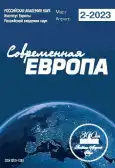Challenges to freedom of religion or belief in the European multicultural context (the case of religious education)
- 作者: Miroshnikova E.M.1
-
隶属关系:
- Leningrad (Pushkin) State University
- 期: 编号 2 (116) (2023)
- 页面: 169-179
- 栏目: Articles
- URL: https://journals.rcsi.science/0201-7083/article/view/144476
- DOI: https://doi.org/10.31857/S0201708323020134
- EDN: https://elibrary.ru/OVMSSP
- ID: 144476
如何引用文章
全文:
详细
作者简介
Elena Miroshnikova
Leningrad (Pushkin) State University
Email: miroshnikovaem@gmail.com
St Petersburg, Russia
参考
- Лункин Р.Н. (2022) Посткризисные настроения в Евросоюзе. Общество и политика в "эру COVID-19". Отв. ред. В.Я. Швейцер. Ин-т Европы РАН, Москва. С. 11-24.
- Мирошникова Е.М. (2021) Знания о религиях в современном европейском образовательном пространстве: проблема подходов к преподаванию. Современная Европа. № 6. С. 167-177. DOI: http://dx.doi.org/10.15211/soveurope62021167177
- Смирнов М.Ю. (2020) Новые форматы религии в публичном пространстве современного российского общества. Технологос. № 1. С. 124-132. DOI: 1015593permkipf2020111
- Balazka D. (2020) Mapping Religious Nones in 112 Countries: An Overview of European Values Study and World Values Survey Data (1981-2020). URL: https://isr.fbk.eu/wp-content/uploads/2020/07/Mapping-Religious-Nones-in-112-Countries-Report.pdf (accessed: 25.12.2022).
- Bielefeldt H. (2021) Freedom of Religion in Europe Today: Under Critical Investigation. ISFORB Conference Leuven, 06-07 May 2021. Freedom of Religion in Europe Today. URL: https://www.etf.edu/event/freedom-of-religion-in-europe-today-under-critical-investigation/(accessed: 25.12.2022).
- Bielefeldt H., Ghanea N., Wiener M. (2016) Freedom of Religion or Belief: an International Law Commentary. Oxford Univ. Press, Oxford, UK. 704 p. doi: 10.1093/law/9780198703983.001.0001
- Breskaya O., De Stefani P., Giordan G. (2022) The Lautsi Legacy: A New Judgment on the Crucifix in Classrooms and the Multiculturalist Turn on Freedom of/from Religion in Italy. Religions. Vol. 13. Issue 7. DOI: https://doi.org/10.3390/rel13070666
- Davis D., Miroshnikova E. (2013) The Routledge International Handbook on Religious Edu-cation. Routledge, London, UK. 442 p.
- Eco U. (2003) Essere laici in un mondo multiculturale. La Repubblica. 29.10. URL: https://ricerca.repubblica.it/repubblica/archivio/repubblica/2003/10/29/essere-laici-in-un-mondo-multiculturale.html (accessed: 25.12.2022).
- ReMinEm (2022) Preventing discrimination and persecution. Models of inclusion of religious minorities in the Euro-mediterranean space (ReMinEm). Final Report. The Center for Religious Studies, Bruno Kessler Foundation, Trento, Italy. 32 p. URL: https://atlasminorityrights.eu/filemanager/pdf/Final_Report.pdf
补充文件









